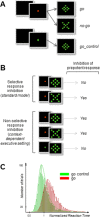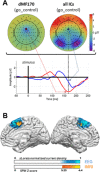The dorsal medial frontal cortex mediates automatic motor inhibition in uncertain contexts: evidence from combined fMRI and EEG studies
- PMID: 24954611
- PMCID: PMC6869116
- DOI: 10.1002/hbm.22567
The dorsal medial frontal cortex mediates automatic motor inhibition in uncertain contexts: evidence from combined fMRI and EEG studies
Abstract
Response inhibition is commonly thought to rely on voluntary, reactive, selective, and relatively slow prefrontal mechanisms. In contrast, we suggest here that response inhibition is achieved automatically, nonselectively, within very short delays in uncertain environments. We modified a classical go/nogo protocol to probe context-dependent inhibitory mechanisms. Because no single neuroimaging method can definitely disentangle neural excitation and inhibition, we combined fMRI and EEG recordings in healthy humans. Any stimulus (go or nogo) presented in an uncertain context requiring action restraint was found to evoke activity changes in the supplementary motor complex (SMC) with respect to a control condition in which no response inhibition was required. These changes included: (1) An increase in event-related BOLD activity, (2) an attenuation of the early (170 ms) event related potential generated by a single, consistent source isolated by advanced blind source separation, and (3) an increase in the evoked-EEG Alpha power of this source. Considered together, these results suggest that the BOLD signal evoked by any stimulus in the SMC when the situation is unpredictable can be driven by automatic, nonselective, context-dependent inhibitory activities. This finding reveals the paradoxical mechanisms by which voluntary control of action may be achieved. The ability to provide controlled responses in unpredictable environments would require setting-up the automatic self-inhibitory circuitry within the SMC. Conversely, enabling automatic behavior when the environment becomes predictable would require top-down control to deactivate anticipatorily and temporarily the inhibitory set.
Keywords: Alpha oscillations; EEG; automaticity; executive control; fMRI; go/nogo; response inhibition; task setting.
Copyright © 2014 Wiley Periodicals, Inc.
Figures




References
-
- Babiloni C, Pizzella V, Gratta CD, Ferretti A, Romani GL (2009): Fundamentals of electroencefalography, magnetoencefalography, and functional magnetic resonance imaging. Int Rev Neurobiol 86:67–80. - PubMed
-
- Bell AJ, Sejnowski TJ (1995): An information‐maximization approach to blind separation and blind deconvolution. Neural Comput 7:1129–1159. - PubMed
-
- Bengson JJ, Mangun GR, Mazaheri A (2012): The neural markers of an imminent failure of response inhibition. NeuroImage 59:1534–1539. - PubMed
Publication types
MeSH terms
Substances
LinkOut - more resources
Full Text Sources
Other Literature Sources

